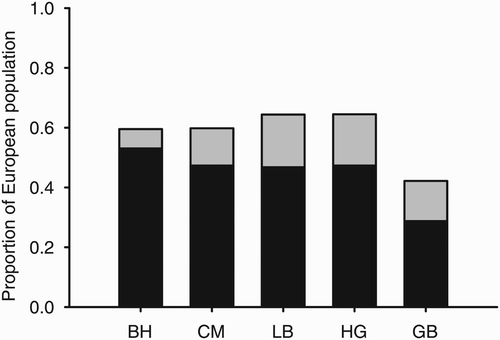Figures & data
Table 1. The statuses in existing conservation listings of the principal species considered in this article.
Figure 1. Stratification used to generate population estimates of wintering gulls in Great Britain, its constituent countries, Northern Ireland, the Channel Islands and Isle of Man, for the five principal species of gull that winter in the UK. Dark grey = tetrads in the inland high water strata; light grey = tetrads in the inland low water strata; white = tetrads in the inland no water strata. Grey lines indicate regional boundaries used in the stratification: 1 = north and west Scotland; 2 = east Scotland; 3 = southwest Scotland; 4 = northwest England; 5 = northeast England; 6 = Wales; 7 = midlands; 8 = East Anglia; 9 = southwest England; 10 = southeast England; 11 = Northern Ireland; 12 = Isle of Man; 13 = Channel Islands. Black indicates inland and coastal key sites.

Table 2. Raw count totals of individual gull species, ‘small gulls’, ‘large gulls’ and ‘unidentified’ gulls used to produce population estimates.
Table 3. Population estimates (with 95% confidence limits in parentheses) for the five principal wintering gull species in Great Britain, its constituent countries, Northern Ireland, the Channel Islands and Isle of Man in 2003/04–2005/06 and in Great Britain and the UK in 1993 (after Burton et al. Citation2003).
Table 4. National and international thresholds (and associated biogeographic population estimates) for the five principal wintering gull species in Great Britain and Northern Ireland used in the identification of important sites.
Figure 2. The proportions of the European winter populations of Black-headed Gull (BH), Common Gull (CM), Lesser Black-backed Gull (LB), Herring Gull (HG) and Great Black-backed Gull (GB) held by the UK, incorporating data from the 1993 UK survey (black columns; BirdLife International Citation2004a), and the increase on these figures suggested by the 2003/04–2005/06 UK survey (grey columns).
